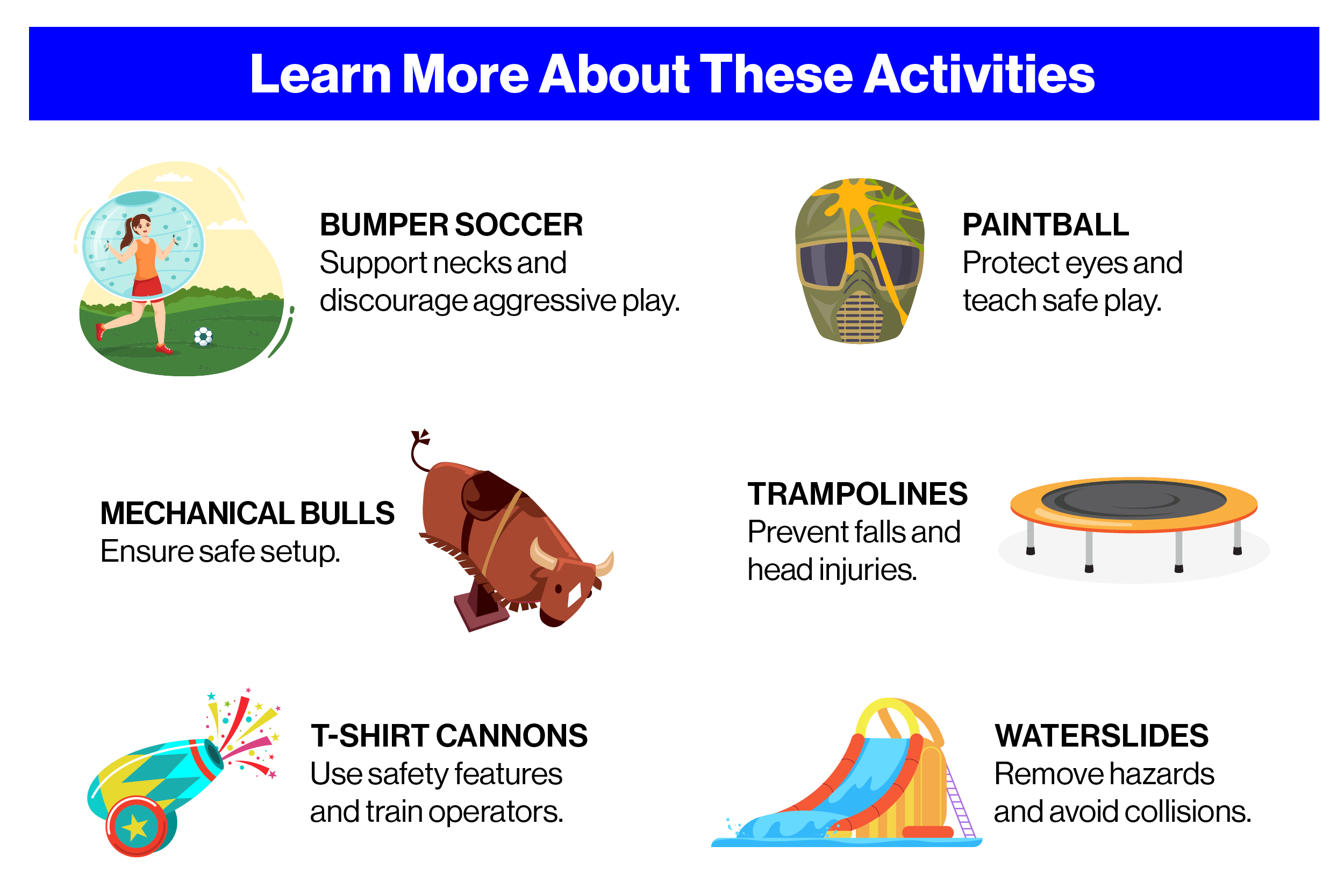Organize Safe Attractions and Games
K-12 schools, colleges, and universities may use activities such as paintball games, trampolines, and mechanical bulls to boost student morale at events like carnivals and pep rallies. These high-risk activities can be dangerous, so it’s imperative to follow proper safety measures.

Prepare for High-Risk Activities
Regardless of which high-risk activity your institution hosts, take these essential risk management actions:
- Communicate that such activities must be approved to occur at your institution.
- Check each vendor’s safety records, qualifications, and any relevant licensing.
- Ensure institution-owned equipment being used for the activity is properly maintained and inspected according to manufacturer guidelines.
- Post signage detailing the risks of the activity, rules, and any age, height, or weight restrictions for participants.
- Prepare accommodations such as large print forms and wheelchair-accessible spaces, where possible, for participants with disabilities.
- Prohibit alcohol consumption at your event.
Staff Your Event Appropriately
Whether you use students, campus employees, or a vendor’s staff as attendants for your high-risk activity, follow these suggestions to prepare staff:
- Recruit event attendants who are trained in first aid and CPR.
- Instruct attendants to constantly supervise the activity.
- Inform attendants of your emergency action plan and emergency response communication plan.
- Consider having an EMT present in the event of an accident or medical emergency.
Protect Your Institution From Liability
Having well-written contracts and waivers can protect your institution in the event of injuries at your attraction or game. Take these steps to help ensure proper legal protection:
- Draft or review all agreements with your local legal counsel.
- Require participants to sign a release and assumption of risk form outlining your activity’s specific risks.
- Discuss with counsel whether releases signed by or on behalf of minors are enforceable in your state.
- Ensure any third-party vendor agreements include favorable indemnity provisions.
Address Activity-Specific Risks
Ensure you understand the specific risks associated with certain high-risk attractions and games.
Paintball
Reduce the risk of paintball injuries by training participants in proper playing technique.
Other safety guidelines include:
- Ensure all players wear masks that meet the relevant ASTM standards for eye protection. Eye injuries are the most common severe injury playing paintball causes, so wearing proper gear is essential.
- Tell players to wear proper attire: long pants and sturdy shoes with ankle support.
- Hold paintball games at reputed spaces designed for the game, where the provider is responsible for the inspection of the site and equipment maintenance.
- Inform your paintball provider of your emergency action plan and emergency response communication plan.
- Include paintball guns in your weapons policy to prevent them from being misused on your campus.
Trampolines
Follow these practices to help avoid injuries involving trampolines:
- Use trampolines with enclosures to prevent injuries caused by falls.
- Ensure trampolines have shock-absorbing pads on their springs, hooks, and frame.
- Allow only one person to use a trampoline at a time.
- Prohibit somersaults, backflips, and other acrobatic stunts.
- Have a separate area for students waiting to use the trampoline to prevent them from being injured by others falling.
- Consider having a minimum height requirement, as smaller children are likelier to get injured playing on trampolines.
- Don’t place trampolines near other structures that could pose a risk of collision to students.
Waterslides
To make waterslides at your event safer:
- Place slides in a location with soft surfaces and away from objects that could pose a collision risk.
- Remove from the area hazards such as rocks, branches, and other sharp objects.
- Have age, height, and weight restrictions based on vendor or manufacturer guidelines.
- Use slides that have riders sitting upright with their feet falling first.
- Instruct riders to remove jewelry, watches, and other loose articles.
- Allow only one rider to use the slide at a time.
- Direct attendants to clear the pool at the bottom of the slide before allowing the next rider to slide down.
- Prohibit riders from climbing up the slide.
T-Shirt Cannons
Though they’re common at sporting events, T-shirt cannons can cause severe injuries. To limit the risk of injury:
- Use cannons with safety features such as automatic trigger locks and proximity gauges.
- Instruct operators to maintain distance from spectators and avoid aiming toward faces.
- Have operators wear eye protection to prevent injuries in the event of a misfire.
Mechanical Bulls/Sharks
Mechanical bulls (or mechanical sharks) also could harm participants and spectators. Follow these precautions to make their use safer:
- Walk your vendor through the area of campus where they will set up the bull/shark. This advance planning helps ensure safety guidelines are followed.
- Ensure there is ample room around the bull/shark to prevent riders from injuring spectators if they are thrown off.
- Discuss with your vendor potential physical, mental, or behavioral conditions that might make someone ineligible to use the bull/shark. Such conditions might include back or neck problems, heart conditions, and seizure disorders.
- Have age, height, and weight restrictions based on your vendor’s guidance.
Bumper Soccer/Bubble Balls
Any game where players wear an inflatable ball may seem safer than traditional activities, but these games also have risks. Because of possible spinal injuries from these games, ensure your players wear proper head protection.
To reduce your institution’s risk:
- Set up games on safe terrain such as grass, turf, and gym floors.
- Don’t host games near pavement, cement, or bodies of water.
- Offer multiple ball sizes so each player’s ball can cover at least 8 inches above the top of their head to protect their head and neck.
- Have height restrictions in place if the balls you offer can’t cover 8 inches above a player’s head for players past a certain height.
- Educate players on safe playing practices.
- Instruct game referees to identify and penalize players for aggressive play or spearing.
More From UE
Increase Bounce House Safety
Checklist: Risk Management for Campus Student Events
Checklist: Drafting Effective Releases
Improving Contracting on Campus: Allocating Risks Between Parties
About the Author
-

Annika Vasagiri
Former Risk Management Intern
Annika Vasagiri was a summer intern with UE’s Risk Management department. While at UE, she was a fourth-year International Affairs and Economics student at George Washington University. As an intern, she researched risk areas affecting educational institutions and the risk mitigation strategies available to them. Prior to joining UE, Annika interned at the U.S. Department of Commerce and completed an exchange semester at the National University of Singapore.